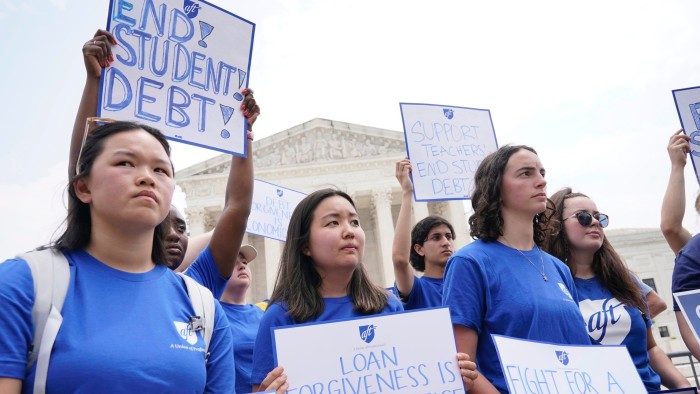Stay informed with free updates
Simply sign up to the US economy myFT Digest — delivered directly to your inbox.
Millions of borrowers of US student loans who are behind on their payments face collections for the first time since 2020, creating a potential drag on consumer spending at a time when the American economy is already stumbling.
Nearly one in four borrowers with payments due were behind on their student loans in the three months to March, according to calculations by the New York Fed Consumer Credit Panel and credit bureau Equifax, published on Tuesday.
The Trump administration has restarted involuntary collections on defaulted federal student loans, and has said it will begin garnishing [or deducting] wages and confiscating tax refunds and social security benefits “later this summer”.
Resuming collections of student loans could pose a challenge for US growth, which contracted by 0.3 per cent on an annualised basis in the first quarter, as borrowers shift funds from spending to debt payments. Nearly 43mn US borrowers owe more than $1.6tn in student debt, according to the US Department of Education.
Calculations by JPMorgan found discretionary spending among Chase cardholders in the three months to March dropped the most in states with higher levels of student loan delinquency. The figures showed that struggling borrowers “faced consequences such as losing access to credit or reduced funds for consumption,” said JPMorgan economist Murat Tasci.
Personal consumption accounts for about 70 per cent of US GDP. Any pullback in spending from student loan borrowers could exacerbate the effects of federal lay-offs and tariffs, because unemployment fears and inflation expectations are already soaring, warned Stephen Brown, an economist at Capital Economics.
“It’s yet another item in a long list of items that’s set to weigh on consumer spending this year,” he said.
The Department of Education paused federal student loan repayments at the start of the Covid-19 pandemic in March 2020. That pause ended in 2023, but the Biden administration implemented a no-consequences period for borrowers who didn’t make repayments until the end of 2024.
The education department also restarted reporting overdue payments to credit agencies at the beginning of the year, striking a blow to many borrowers’ credit scores. Economists warned that this move was already weighing down the consumer spending that powers the US economy.
Almost 8 per cent of aggregate student debt was more than 90 days delinquent in the first quarter of 2025. That figure could rise further because many Americans’ loans are still in forbearance while litigation around Biden-era relief programmes — including several income-driven repayment plans — plays out in court.
However, the return of student loan payments is already pushing more households towards delinquency. The share of US consumer debt that was more than 30 days overdue in the first quarter of 2025 was 4.9 per cent, the highest in a decade, according to the New York Fed.
Trump signed an executive order in March aimed at limiting eligibility for the Public Sector Loan Forgiveness Program, introduced under President George W Bush, which allows many non-profit and government employees to have their federal student loans cancelled after ten years of payments.
“A high and rising number of American households are under mounting financial stress,” said Mark Zandi, chief economist at rating agency Moody’s.




